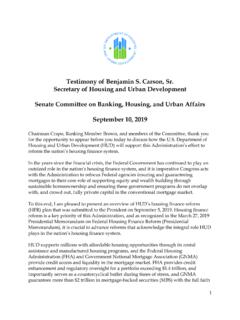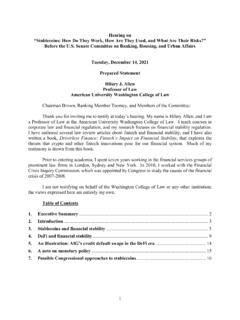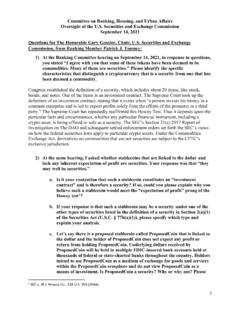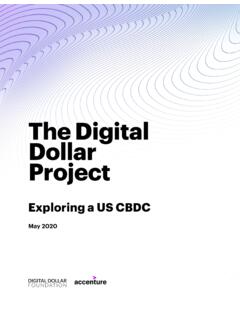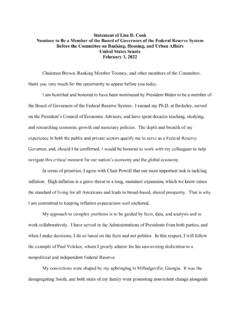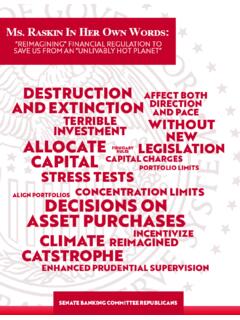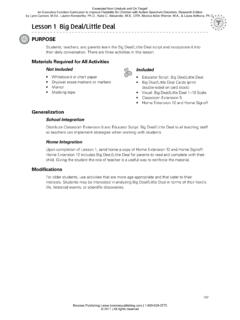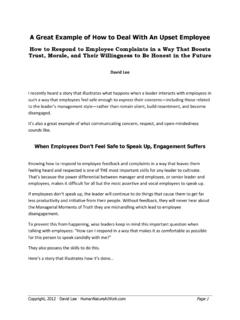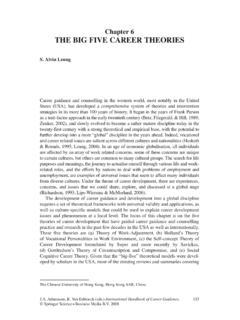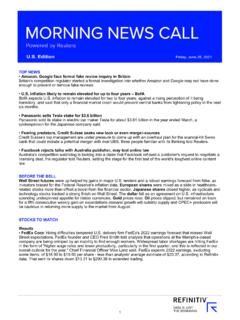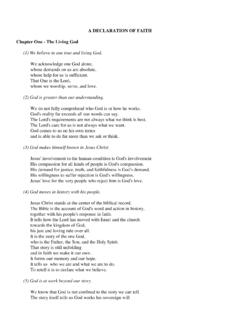Transcription of THE NEW DEAL: ACCOMPLISHMENTS AND FAILURES
1 1 THE NEW deal : ACCOMPLISHMENTS AND FAILURES Allan M. Winkler Distinguished Professor of History Miami University Oxford, Ohio Testimony before the Senate Committee on Banking, Housing, and Urban Affairs March 31, 2009 The New deal was a response to the worst economic crisis in American history. As the United States suffered from the ravages of the Great Depression, the administration of Franklin D. Roosevelt, which took office in March 1933, tried a host of different, often contradictory measures in an aggressive effort to provide relief for the unemployed, to prompt the recovery of the faltering economic system, and to propose the kind of structural reform that could protect people in future crises. But the New deal was never a coherent, interconnected effort to deal with the various dimensions of the Depression in a systematic way. Rather it was a multi-faceted attmept to deal with different elements of the catastrophe in ways that sometimes seemed haphazard and occasionally were contradictory.
2 On balance, though, the New deal enjoyed some notable ACCOMPLISHMENTS , even if it failed to promote full-scale economic recovery. The Great Depression was an economic disaster. While the stock market crash of 1929 need not have precipitated a depression, structural weaknesses in the economy, unbridled speculation in financial markets, and lack of regulation on Wall Street led to an unprecedented economic calamity that soon affected the entire world economy. In the United States, unemployment was the chief symptom of the depression, and by the time FDR took office there were approximately 13 million people unemployed fully one quarter of the working population with another quarter underemployed. In some cities, unemployment reached 75 percent. 2 The response of President Herbert Hoover did little to alleviate distress. Though he took a more activist role that many of his predecessors, his own commitment to individualism and belief that government should not play an aggressive role in an economic bailout impeded action, and the few measures he did take had little impact.
3 Even the Reconstruction Finance Corporation, established as a result of Democratic pressure, proved unable to reduce unemployment in the Hoover years. Franklin D. Roosevelt, elected in 1932, had no clear sense of what he might do when he assumed office. Some people viewed him as something of a lightweight. Journalist Walter Lippmann called him an amiable boy scout, and on another occasion said, He is a pleasant man who, without any important qualifications for the office, would like very much to be president. But Roosevelt s experience as Governor of New York for two terms taught him how he might respond to the economic crisis. FDR struck just the right note in his inaugural address. At a time when bank FAILURES across the country swept away the savings of millions of small investors, he promised action, and action now, and he boosted spirits with his stunning assertion that the only thing we have to fear is fear itself.
4 It was clear evidence of a sense of self-confidence and self-assurance that played a powerful part in helping Americans feel better in the midst of hard times. Just as the presidency had been a bully pulpit for Theodore Roosevelt, it was preeminently a place of moral leadership for FDR. Then he embarked on what came to be called the First Hundred Days. There was no blueprint. Roosevelt needed to do something about the banks, and so, working with officials left over from the Hoover administration, he proposed a bank holiday. The Emergency Banking Act authorized the Federal Reserve Board to issue new bank notes, allowed the reopening of banks that had adequate assets, and arranged for the reorganization of those that did not. With that somewhat surprising success, he pushed ahead with a measure to cut the budget, for the conventional wisdom held that a balanced budget was necessary for economic health, and then a bill to legalize beer, to help make people happy as Prohibition came to an end.
5 By the time the First Hundred Days came to an end, he had made 10 major speeches, sent 15 messages to 3 Congress, and helped push through the passage of 15 major pieces of legislation. It was, in short, the most extraordinary period of legislative actifvity in American history. And it set the tone and template for the rest of the New deal . Overall, what did the New deal do? First, it addressed the unemployed. A Federal Emergency Relief Administration provided direct assistance to the states, to pass it on to those out of work. The next winter, a work-relief program provided jobs in the brief period it existed. Then, in 1935, FDR created the Works Progress administration, which paid all kinds of people, including artists, actors, and authors, to work and built new schools, bridges, and other structures around the country. It was expensive, to be sure, but it made a huge economic and emotional difference to the people it assisted.
6 Second, the New deal sought to do something to promote recovery. The National Recovery Administration attempted to check unbridled competition which was driving prices down and contributing to a deflationary spiral. It tried to stabilize wages, prices, and working hours through detailed codes of fair competition. Meanwhile, the Agricultural Adjustment Administration sought to stabilize prices in the farm sector by paying farmers to produce less. Finally, over the course of the New deal , the administration addressed questions of structural reform. The Wagner Act, which created the National Labor Relations Board in 1935, was a monumental step forward in giving workers the right to bargain collectively and to arrange for fair and open elections to determine a bargain agent, if laborers so chose. The Social Security Act the same year was in many ways one of the most important New deal measures, in providing security for those reaching old age with a self-supporting plan for retirement pensions.
7 But there were other reform measures as well. The Securities and Exchange Commission and Federal Deposit Insurance Corporation were new. And the Glass-Steagall Act, only recently repealed with frightful consequences, separated commercial and investment banking. The New deal was responsible for some powerful and important ACCOMPLISHMENTS . It put people back to work. It saved capitalism. It restored faith in the American economic system, while at the same time it revived a sense of hope in the American people. But economically, it was less successful. 4 Monetary policy, as Christina Romer has suggested, made the most difference. Fiscal policy didn t really work because it wasn t really tried. Why, then did the New deal fail to achieve economic recovery? The answer rests with the theoretical speculations of English economist John Maynard Keynes. In 1936, he published his powerfully important book The General Theory of Employment, Interest and Money, but he had been lecturing about the concepts for several years to his Cambridge University students.
8 Basically, Keynes argued that depressions would not disappear of their own accord. It was rather necessary to take aggressive action to jumpstart the economy. Ideally, such action should come from the private sector. But if such a response was not forthcoming, the government could act instead. It could spend massive amounts of money on public works or other projects, or cut taxes, or both. What was necessary, in Keynes s phrase, was deliberate, sustained countercyclical spending. Keynes came to the United States and had one ill-fated meeting with FDR. Neither man understood the other. Keynes remarked that he had supposed that the President was more literate, economically speaking. FDR simply commented that Keynes left a whole rigaramole of figures. He must be a mathematician rather than a political economist. And that was that. Furthermore, the New deal often worked in counterproductive ways, at least economically.
9 Whereas Keynes demanded what we would today call a major stimulus package, and while the New deal did spend more than ever before, it also embarked on contradictory initiatives. For example, the Agricultural Adjustment Administration spent large amounts of money to take land out of circulation, to cut down on production and thereby raise prices. But it diminished the effect of that spending by paying for it with a sizeable processing tax. Likewise, Social Security, which aimed to plow a huge amount of money into pensions, was not slated to make payments until 1942, but began taking money out of circulation through a withholding tax long before then. The New deal also alienated businessmen, something Keynes counseled against. Businessmen have a different sense of delusions from politicians, he once said. You could do anything you liked with them, if you would treat them (even the big ones) not as wolves and tigers but as domestic animals by nature, 5 even though they have been badly brought up and not trained as you would wish.
10 The NRA alienated business, and never did encourage private expansion or investment. It may have halted the deflationary spiral, but it failed to create new jobs. And it contributed to a measure of ill will. As Roosevelt got frustrated, his rhetoric marginalized business interests. Speaking of business interests in the reelection campaign of 1936, he proclaimed, They are unanimous in their hate for me and I welcome their hatred. That may have helped politically, but it hurt economically. Fiscal policy, in short, along the lines Keynes counseled, did not work because it was never really tried. The unemployment rate never dropped below 14 percent, and for the entire decade of the 1930s, it averaged 17 percent. Slowly, however, the New deal learned fiscal lessons In 1937, assuming that the economy was improving and could manage without assistance, Roosevelt slashed half of all WPA jobs and cut the allocation to less than a third of what it had been.
